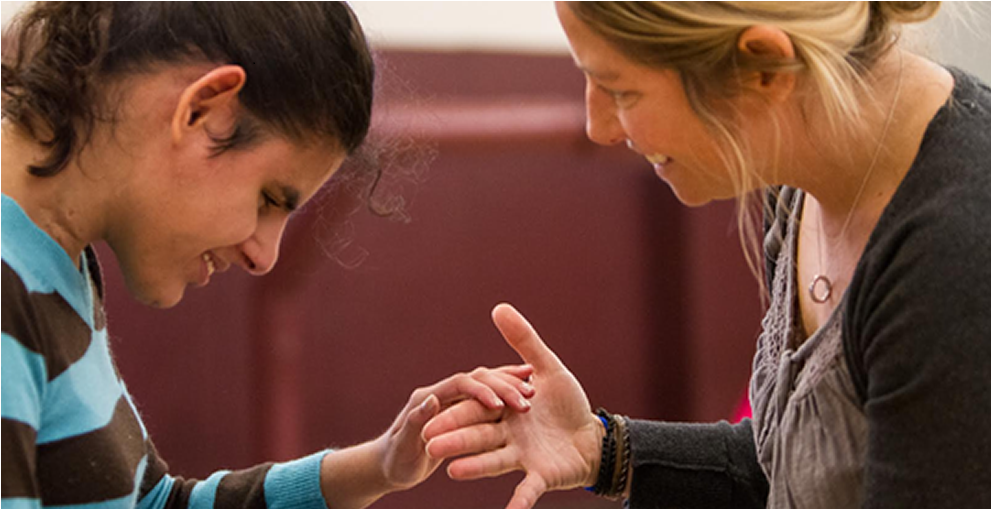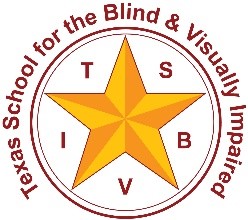Let's Talk Deafblind Eligibility
You may download a pdf version of Lets-Talk-Eligibility and the Fact Sheet for Parents – Texas Deafblind Child Count which includes the content shown on this page plus some information for parents.
Texas Administrative Code (TAC) §89.1040. Eligibility Criteria.
on the evaluations specified in subsections (c)(3) and (c)(12) of this section:
section and visual impairment specified in subsection (c)(12) of this section;
hearing loss that cannot be demonstrated conclusively, but a speech/language therapist, a
certified speech and language therapist, or a licensed speech language pathologist indicates
there is no speech at an age when speech would normally be expected;
requirements for deaf or hard of hearing or visual impairment, but the combination of such
losses adversely affects the child’s educational performance; or
concomitant hearing and visual losses that, without special education intervention, will
adversely affect the student’s educational performance.
2. Question: Why should the IEP committee consider deafblind (DB) eligibility?
Answer(s):
- A student with a dual sensory impairment, i.e. deafblind, may have very different needs than those who have a single sensory impairment, i.e. vision impairment (VI) or Deaf/hard of hearing (DHH). It is important for the student, or their family and school staff to consider access from a combined sensory loss (deafblind) perspective. Staff who are trained in a single sensory area may need additional support to identify and implement deafblind-specific educational assessments, programming strategies, and resources to develop an appropriate IEP.
- Typical educational approaches for students who are DHH involve the use of vision as a compensatory strategy. For students who are visually impaired, compensatory approaches often rely upon the use of hearing. Identifying a student as deafblind may provide a clearer description of the student’s educational needs.
- There are specific resources and unique services for young children and students who are deafblind, their families, and school staff. Resources are included in number 7 below.
- If a student qualifies for DB eligibility, it is not necessary to also list the DHH and/or VI eligibility. The DB eligibility code encompasses both areas.
3. Question: Does deafblind eligibility qualify a student for additional services that the DHH/VI eligibility does not?
Answer(s):
- As with all students who receive Special Education, services are determined by individual needs based on evaluation data and the present levels of academic achievement and functional performance (PLAAFP). At this time, there is not additional DB service per se that is added to a student’s schedule. All students with both VI and DHH eligibility will be counted on the Deafblind Child Count and can access the support of the Texas Deafblind Project. Currently, there is not certification for teachers of students who are deafblind (TDB), but this certification is currently under development by the State Board of Educator Certification (SBEC), so additional services from a teacher who is specially trained in the area of educating students who are deafblind will likely become a consideration in the future.
- Deafblind eligibility alerts the educational team that the student will have unique needs and that additional resources might benefit the student, family, and instructional team. The ARD team might need to consider resources or supports related to counseling, tactile sign, braille instruction, orientation and mobility, or others.
4. Question: Why should a student who has a mild visual impairment and is hard of hearing be considered deafblind?
Answers(s):
TAC Code states that: A student with deaf-blindness is one who:
(C) “Has documented hearing and visual losses that, if considered individually, may not meet the requirements for deaf or hard of hearing or visual impairment, but the combination of such losses adversely affects the child’s educational performance;”
- The question to consider is whether the combined effects of the mild differences in vision and hearing impact educational performance. Do these combined sensory levels affect the student’s ability to gather information and fully participate in their education? If so, the student may need specially designed instruction, modifications, accommodations, special technology, or unique strategies that require both the teacher of students with visual impairments (TSVI), a teacher of students who are deaf/ hard of hearing (TDHH), the Certified Orientation and Mobility Specialist (COMS), and if available, a teacher of students who are deafblind (TDB) to participate in assessment and program development.
- If a student qualifies as deafblind under the eligibility criteria in section (C), a TSVI, TDHH, and if possible, a COMS, and TDB will participate in the student’s IEP meeting.
5. Question: What is the difference between the IDEA Count and the Deafblind Child Count?
Answer(s):
There are two separate counts that students who are deafblind are reported on each year. The first is the US Department of Education’s count of students receiving special education services required by the Individuals with Disabilities Education Act (IDEA). The second is the Deafblind Child Count that is collected by the Office of Special Education Programs (OSEP).
IDEA Count:
- The US Department of Education is required by IDEA to report to Congress annually on the number of children receiving special education, by disability category, for ages 3-21 years. The count must be unduplicated – that is, children can only be counted in one category, regardless of the number of disabilities they experience. See: https://sites.ed.gov/idea/data/ and https://www.afb.org/research-and-initiatives/education/education-initiatives-afb/estimates-severely-visually-impaired
Deafblind Child Count:
- The Texas Education Agency (TEA) Division of Special Education is required to report annually on individuals, birth -21 years of age, who are deafblind in Texas. This information, collected by State Deafblind Projects, informs the National Deafblind Child Count recorded by OSEP. See: https://www.nationaldb.org/info-center/national-child-count/
- The Deafblind Child Count collects different information than the IDEA count and provides information that is used for regional and statewide planning to develop appropriate services for infants, children, and youth who are deafblind and determine funding priorities.
6. Question: Why is it recommended that deafblind be ranked as the primary disability?
Answer(s):
The primary ranking is the only one reported to the federal government for IDEA count. Therefore, unless the deafblind eligibility is stated as the primary disability it will not be recorded on this count. This information is used in policy development. Since deafblind eligibility is the rarest of the low-incidence eligibility groups, it is important to be sure these students are not missed. Policymakers may not see the separate Deafblind Child Count that OSEP collects from the state Deafblind Projects.
The primary eligibility category should be representative of the disability that has the greatest impact on the student’s education. It would be a rare occasion that any one disability would impact a student’s access to their education more than an impairment in both of their distal senses. Only in those rare situations, should something other than deafblind be the primary disability category.
7. Question: What information on community and state service resources for individuals who are deafblind is provided for families, young children, and school-age students?
Answer(s):
Due to the low incidence of individuals who are deafblind, information about specific resources is often not included in the typical resource packets distributed by school professionals to families of students regarding vision loss and services available for young children and students who are Deaf/hard of hearing.
It should be noted that there are specific resources and unique services for students who are deafblind and their families. For instance:
- Texas Deafblind Project (https://txdeafblindproject.org/)
- Deafblind services through Health and Human Services and Texas Workforce Commission (https://www.hhs.texas.gov/providers/long-term-care-providers/deaf-blind-multiple-disabilities-dbmd)
- National Center on Deaf-Blindness (https://www.nationaldb.org/)
- National Family Association for Deaf-Blind (https://www.nfadb.org/)
- Deafblind Multiple Disabilities Medicaid Waiver (https://www.hhs.texas.gov/providers/long-term-care-providers/deaf-blind-multiple-disabilities-dbmd)
- Helen Keller National Center (https://www.helenkeller.org/)
- iCanConnect (https://www.icanconnect.org/)
8. Question: If the Texas Deafblind Child Count is due before the process of determining eligibility is complete, should the child be reported?
Answer(s):
Yes, students who have suspected hearing and vision losses should be reported on the Deafblind Child Count. These students may remain on the child count for one year. During that year, evaluation of the student’s sensory functioning should be completed. Technical assistance related to appropriate assessment techniques is available from the Texas Deafblind Project at the Texas School for the Blind and Visually Impaired.
Instructions for Completing the Deafblind Child Count
Although, at this time, deafblind is not recognized as a separate disability condition within the early childhood intervention (ECI) system in Texas, it is critical to identify these infants and young children on the Deafblind Child Count so their families and support providers have access to personnel and resources.
For more information please contact txdeafblindproject@tsbvi.edu.
(A) meets the eligibility criteria for deaf or hard of hearing specified in subsection (c)(3) of this section and visual impairment specified in subsection (c)(12) of this section;
(B) meets the eligibility criteria for a student with a visual impairment and has a suspected hearing loss that cannot be demonstrated conclusively, but a speech/language therapist, a certified speech and language therapist, or a licensed speech language pathologist indicates there is no speech at an age when speech would normally be expected;
(C) has documented hearing and visual losses that, if considered individually, may not meet the requirements for deaf or hard of hearing or visual impairment, but the combination of such losses adversely affects the child’s educational performance; or
(D) has a documented medical diagnosis of a progressive medical condition that will result in concomitant hearing and visual losses that, without special education intervention, will adversely affect the student’s educational performance.”

